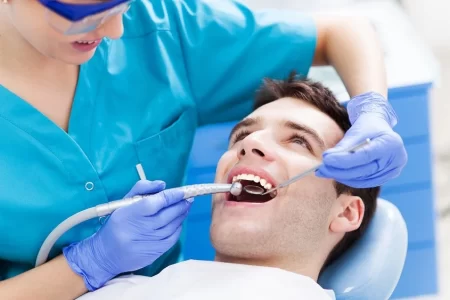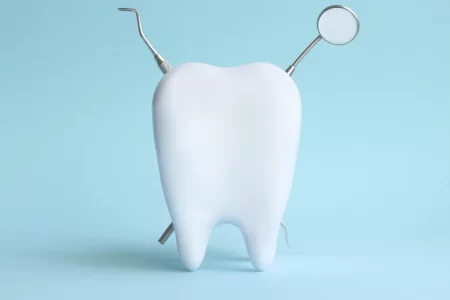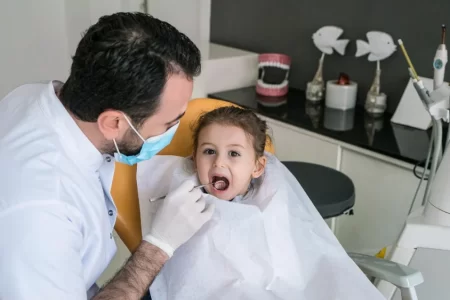Tooth Crown Procedure: Overview and Precautions
- Updated on: Jun 24, 2024
- 6 min Read
- Published on Jul 19, 2019


What is a tooth crown procedure or a dental crown procedure?
A dental crown or a dental cap is a prosthetic cover which is cemented onto a damaged tooth. The major purpose of a tooth crown is protection and covering of a damaged tooth. It also strengthens the tooth and provides a perfect alignment in your mouth.
A dental crown is prepared in two separate visits to your dentist. It is a long process where the dentist analyzes your defected tooth, attaches a temporary crown for a few days and finally prepares and places a permanent crown over the defected tooth. The dental crown procedure is performed in two stages or visits, which are as follows:
First Visit: Examination and Placement of a Temporary Crown
- If you experience extreme pain or observe any broken or fractured tooth, you should visit your dentist immediately.
- He or she may perform an oral examination of your tooth and identify the cause of your tooth decay symptoms.
- He or she may carry out X-rays of your affected tooth and the surrounding gums to identify if you need a tooth crown or a dental cap to treat the affected tooth.
- In case of extensive decay of your tooth or chances of any infection or injury which may occur in the tooth’s pulp, the dentist may recommend a root canal surgery before covering your tooth using a tooth crown.
- The dentist may give a local anesthesia injection to numb the affected tooth and the surrounding gums, so that you may not feel any pain during the procedure.
- The dentist may build-up your tooth to provide it with a better shape and structure for the dental crown to fit over it. It involves refilling of the affected tooth along with the chewing surface and sides of the tooth. This helps in restoring the original form of your tooth.
- A build-up is usually carried out when you have undergone a root canal treatment or a large area of your tooth is missing due to tooth decay or damage or if you had a tooth fracture.
- Further, the damaged tooth is shaped to allow perfect fitting of the dental crown. The extent of tooth shaving depends upon the type of tooth crown placed over the affected tooth.
- Once your affected tooth is completely shaped, your dentist will apply a paste or putty to create an impression of your tooth.
- This impression of your tooth is used to design the tooth crown as per the structure and orientation of your original tooth. The impression involves the structure of the above and below teeth in the affected tooth region, so that the crown does not interfere with your bite.
- In some cases, the impression of the tooth is prepared using a digital scanner.
- If your tooth crown is made out of porcelain or ceramic material, your dentist may use a shade card to identify the perfect shade of your teeth to prepare a matching dental crown.
- The impression and shade color is sent to the laboratory for preparation of the permanent crown by the technician.
- Till the time a permanent crown is prepared, the dentist fits a temporary crown to cover and protect the prepared tooth. A temporary crown is prepared using stainless steel or acrylic material and fixed on the tooth using temporary cement.
Second Visit: Attachment of a Permanent Crown
- After two or three weeks, the permanent crown will be ready for attachment on the affected tooth.
- The dentist may remove the temporary crown and then he may (or sometimes may not) numb the affected tooth area by applying a local anesthesia injection.
- Before attachment of a permanent crown, he may check the shade and fitting of the prepared crown.
- If the crown is acceptable to the user, the dentist may cement the permanent crown using a permanent cement or permanent glue.
More: What Are Probiotics And Their Benefits In Tooth Decay?
More: What Can I Do To Keep Cavities From Forming?
How are dental crowns made in a laboratory?
The following steps are involved during the preparation of a tooth crown:
- Your dentist sends images and impression of your affected tooth to the lab technician.
- The images and impression contain information about the structure and shape of your tooth along with the shape of the surrounding teeth next to it and below it.
- This information helps the technician to create a mold of your tooth which appears as your original tooth and fits completely along with its adjacent and below teeth.
- It is designed in such a manner that the tooth crown does not interfere with your bite.
- Using this mold, the technician mix up another type of impression which they pour over it, to fill spaces and create the exact structure of your original tooth.
- Once the mold is completely ready, fabrication of the dental crown is initiated.
- The fabrication of metal-based crowns is carried out at extremely high temperature, as molten form of metal is required to re-shape the substance. Porcelain exists in liquid state, but it still requires high temperature to cure and harden it once it is in its perfect shape.
- Tooth crowns may require a high temperature of about 130 degree Celsius and they may be heated up for eight hours to ensure that they are completely set and cured.
- Once they are completely cooled and set, the mold can be broken apart to remove the dental crown.
- Finally, finishing coats are applied over the crown and it is dispatched to a dentist’s clinic.
Difficulties after a Tooth Crown Procedure
You may face a large number of problems after getting a tooth crown or a dental cap. These are as follows:
Discomfort or Sensitivity
As the effect of anesthesia wears off, you may feel sensitivity in and around the crowned tooth. If you had a crown attached close to the nerve of your affected tooth, you may experience hot or cold sensitivity. You dentist may recommend use of a sensitive toothpaste to brush your teeth.
If you experience tooth crown pain and sensitivity when you bite down, it indicates that the crown is attached too high on your tooth. In such a situation, you should consult your dentist to fix the problem.
During a dental crown procedure, a lot of stress is exerted on your tooth. In some cases, this can lead to irreversible inflammation of the nerves surrounding the affected tooth. If such a situation occurs, you dentist may recommend a root canal treatment for its cure.
Chipped Crown
Porcelain and porcelain-fused to metal crows have a tendency to chip off easily. If a small portion of the crown is chipped off, the dental crown is repaired using a composite resin while it remains in your mouth. If extensive chipping occurs, the complete crown will be replaced by your dentist.
Loose Crown
In some cases, the cement may wash out from under the crown. This leads to loosening of the crown and it allows entry of bacteria or fungal organisms in your tooth. This can further lead to tooth decay and may increase its complications. If you observe a loose crown, immediately contact your dentist.
Crown Falls off
If your crown has fallen off, then you can clean the crown and remaining tooth which was covered with the crown. The tooth crown may fall off due to decay of the underline teeth or due to loosening of the cementing material which is used to fix the crown.
You can replace the tooth crown temporarily using dental adhesives or temporary tooth cements which are easily available in the market. You can contact your dentist as he may recommend specific instructions to take care of your crown till the time you visit his clinic.
Your dentist will try to re-cement the fallen crown in its place or he may replace it with a fresh crown.
Allergic Reactions
The material commonly used to make dental crowns is a mixture of metals, which may be allergic to some individuals. An allergic reaction to a metal-based or porcelain crown is a rare event.
Dark Line on Crowed Tooth Next to the Gum Line
In porcelain fused to a metal-based crown, appearance of a dark line next to the gum line on a crowed tooth is a common event. The dark line represents the metal which is fused with porcelain. It does not cause any medical problem, but it is cosmetically unacceptable and will be replaced using an all-porcelain or all-ceramic crown by your dentist.
See also: What to Do for a Toothache Due To Dental Cavity?
See also: What You Should Know About Bad Teeth or Ugly Teeth?
Precautions after Attachment of a Temporary Crown
Temporary dental crown is a type of temporary fix for a permanent crown. It is necessary to take all necessary precautions after getting a temporary crown. These measures include:
- You should avoid sticky and chewy food items such as chewing gum and caramel. These foods have an ability to pull and grab the crown off from its site of attachment.
- You can minimize the use of the side of mouth where the temporary crown has been attached. Shift the major bulk of chewing to the other side of the mouth.
- You should avoid chewing hard food items such as raw vegetables and some fruits, as it can dislodge or break the temporary crown.
- You can slide rather than lift out the dental floss while cleaning between the teeth and thereby prevent pulling out of the temporary crown.
What special care is required for a crowed tooth?
A crowed tooth does not require any special care or attention. A tooth crown provides support to your existing teeth, but they do not reduce the chances of any tooth decay or gum disease. You should keep following certain basic oral hygiene practices such as:
- You should brush your teeth at least twice a day using a fluoride toothpaste
- You should floss your teeth daily, particularly around the crown area where the gums meet the tooth
You can rinse your mouth with an antibacterial mouthwash at least once in a day











